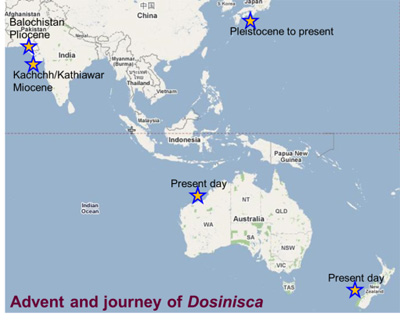 Ancestry of Dosinisca, a mollusc genus that had been reported in 1902 in Japan and so far presumed to have originated in the Indo-Pacific Region, has now been traced in Kachchh in Gujarat as fossils much older than previously thought.
Ancestry of Dosinisca, a mollusc genus that had been reported in 1902 in Japan and so far presumed to have originated in the Indo-Pacific Region, has now been traced in Kachchh in Gujarat as fossils much older than previously thought.
Scientists from Agharkar Research Institute (ARI), Pune an autonomous institute under the Department of Science & Technology, Govt. of India have found the fossil representatives of the clam or bivalve in sedimentary rocks which were formed 22 million years ago in Abdassa Tehsil of Kachchh in Gujarat.
Earlier studies had shown that the species currently known from the marine waters of the Indo-Pacific region of New Zealand, Australia, and Japan, is 2.5 million years old. Reported in 1902 as a modern genus after its findings in Japan, Dosinisca was presumed to have originated in the Indo-Pacific Region, with its antiquity in the Pleistocene Epoch (2.5 million years ago).
Similarly, at the beginning of the twentieth century, fossil molluscs formed some 5.3 million years ago were reported from the sedimentary rocks of Sindh and Baluchistan Provinces of Pakistan. These were reported as some other genus.
Dr. Kantimati Kulkarni, Senior Scientist, Biodiversity & Palaeobiology Group, ARI, and Dr. VidyadharBorkar (ARI retired Scientist) have been studying molluscan fossils for the past two decades. While investigating the claims made earlier from the Miocene Epoch occurring in Kachchh, the two fossil investigators found fossils of Dosinisca from the sedimentary rocks, which were formed 22 million years ago in the Abdassa Tehsil of Kachchh in Gujarat.
Dr. Kulkarni and Dr. Borkar showed in the study published in the Journal of Earth System Science that certain clams described earlier under the name of some other genus were in reality species of Dosinisca.
 Explaining the tracing of the origin and migration of the species Dr. Kulkarni said, "During the early part of Miocene Epoch (23 million to 5.3 million years ago), vast expanses in Kathiawar, Kachchh, and Sindh were inundated by marine waters as a result of a marine transgression around 22 million years ago."
Explaining the tracing of the origin and migration of the species Dr. Kulkarni said, "During the early part of Miocene Epoch (23 million to 5.3 million years ago), vast expanses in Kathiawar, Kachchh, and Sindh were inundated by marine waters as a result of a marine transgression around 22 million years ago."
The two scientists have earlier published a research paper mentioning that certain marine animals had migrated up to the northwest of Australia during that period through the East Indies and the Timor Island. At about the same time, the last phase of an uplifting of the Himalayas was completed.
Migrating to the north was not possible as there was barrier in the form of newly formed Himalayas. Certain genera managed to migrate towards the East Indies. In the course of time, their descendants migrated to the Indopacific region.
The study by Dr. Kulkarni and Dr. Borkar demonstrates that the genus Dosinisca evolved in the temporary sea, which resulted from the marine transgression in early Miocene times in Kachchh.
References: Borkar VD and Kulkarni KG. 2019. The oldest record of the bivalve Dosinisca Dall and its implications. J. Earth Syst. Sci., 128:106. Indian Academy of Sciences https://doi.org/10.1007/s12040-019-1125-6
Borkar VD, Kulkarni KG, and Kapoor S. 2016. An overview of fossil molluscs from the Miocene sediments of Kachchh. Spec. Publ. Geol. Soc. India, No.6, pp.89-105
For more details please contact: Dr. Kantimati G. Kulkarni, Email: kgkulkarni[at]aripune[dot]org






























